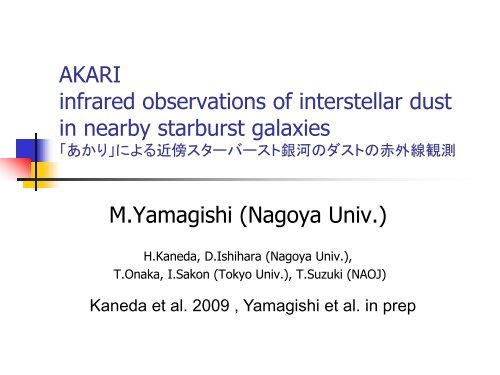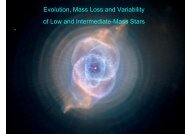Boomsma et al. 2005
Boomsma et al. 2005
Boomsma et al. 2005
Create successful ePaper yourself
Turn your PDF publications into a flip-book with our unique Google optimized e-Paper software.
AKARI<br />
infrared observations of interstellar dust<br />
in nearby starburst g<strong>al</strong>axies<br />
「あかり」による近傍スターバースト銀河のダストの赤外線観測<br />
M.Yamagishi (Nagoya Univ.)<br />
H.Kaneda, D.Ishihara (Nagoya Univ.),<br />
T.Onaka, I.Sakon (Tokyo Univ.), T.Suzuki (NAOJ)<br />
Kaneda <strong>et</strong> <strong>al</strong>. 2009 , Yamagishi <strong>et</strong> <strong>al</strong>. in prep
Contents<br />
� Introduction of Starburst g<strong>al</strong>axies<br />
- NGC 253 & NGC 3079<br />
� Observation of NGC 253<br />
� Observation of NGC 3079<br />
� Compare NGC 253 with NGC 3079
Type,<br />
Distance<br />
NGC253 & NCG3079<br />
NGC253 NGC3079<br />
Edge-on, SAB(s)c,<br />
3.5Mpc<br />
Edge-on, Sbc,<br />
15Mpc<br />
Classification Starburst Seyfert2<br />
Interesting<br />
phenomenon<br />
Dust outflow??<br />
(Radovich <strong>et</strong> <strong>al</strong>.2001)<br />
(Starburst)<br />
G<strong>al</strong>actic superwind<br />
(Cecil <strong>et</strong> <strong>al</strong>.2001 <strong>et</strong>c)
Type,<br />
Distance<br />
NGC253 & NCG3079<br />
NGC253 NGC3079<br />
Edge-on, SAB(s)c,<br />
3.5Mpc<br />
Edge-on, Sbc,<br />
15Mpc<br />
Classification Starburst Seyfert2<br />
Interesting<br />
phenomenon<br />
Dust outflow??<br />
(Radovich <strong>et</strong> <strong>al</strong>.2001)<br />
(Starburst)<br />
G<strong>al</strong>actic superwind<br />
(Cecil <strong>et</strong> <strong>al</strong>.2001 <strong>et</strong>c)
Type,<br />
Distance<br />
NGC253 & NCG3079<br />
NGC253 NGC3079<br />
Edge-on,SAB(s)c,<br />
3.5Mpc<br />
Edge-on,Sbc,<br />
15Mpc<br />
Radovich Classification <strong>et</strong> <strong>al</strong>. 2001 Starburst IRAS 100um Seyfert2<br />
But ! This is an effect of saturation.<br />
(Starburst)<br />
(Melo <strong>et</strong> <strong>al</strong>.2002)<br />
Interesting Dust outflow??<br />
phenomenon<br />
(Radovich <strong>et</strong> <strong>al</strong>.2001)<br />
G<strong>al</strong>actic superwind<br />
(Cecil <strong>et</strong> <strong>al</strong>.2001 <strong>et</strong>c)
Type,<br />
Distance<br />
NGC253 & NCG3079<br />
NGC253 NGC3079<br />
Edge-on,SAB(s)c,<br />
3.5Mpc<br />
Edge-on,Sbc,<br />
15Mpc<br />
Classification StarburstRed:Hα, Green:I Seyfert2band,<br />
Blue:X-ray (Starburst)<br />
Interesting<br />
phenomenon<br />
Dust outflow??<br />
30”<br />
(Radovich <strong>et</strong> <strong>al</strong>.2001)<br />
15”<br />
http://chandra.harvard.edu/photo/2003/ngc3079/<br />
G<strong>al</strong>actic superwind<br />
(Cecil <strong>et</strong> <strong>al</strong>.2001 <strong>et</strong>c)
AKARI satellite<br />
JAXA<br />
10 IR bands for NGC3079<br />
� Launched in on Feb 21,2006 (UT)<br />
� 13 photom<strong>et</strong>ric bands(2-180um)<br />
� Now in phase 3 II<br />
4 FIR bands for NGC253
Observation of NGC253<br />
� Instrument : FIS (Far-Infrared Surveyor )<br />
� 4 photom<strong>et</strong>ric bands (65,90,140,160um)<br />
� Observation AOT : FIS01(CDS mode)<br />
� Date : 2007 Jun 21<br />
� We did not use narrow band images (65,160um) because<br />
of the ghost sign<strong>al</strong>s.
FIR emission<br />
We d<strong>et</strong>ected FIR dust emissions in the h<strong>al</strong>o of NGC 253.<br />
(90um) (140um)<br />
4'<br />
4'
(90um)<br />
Dust mass in the h<strong>al</strong>o<br />
4'<br />
R = 2 ’ ( ~ 2kpc )<br />
� Emissivity power-low index b<strong>et</strong>a = 1,<br />
mass density = 3g/cm^3 and dust size<br />
0.1um are assumed.<br />
� We adopt the grain emissivity factor<br />
given by Hildebrand 1983.<br />
� h<strong>al</strong>o1 :Td = 20K, Md = 1.1×10^6 Msun<br />
� h<strong>al</strong>o2 : 23K, 9.1×10^5 Msun
Other results<br />
90um + X-ray contour<br />
Dust emissions is correlated<br />
with X-ray emission.<br />
B: optic<strong>al</strong> G: HI 21cm R: X-ray<br />
<strong>Boomsma</strong> <strong>et</strong> <strong>al</strong>. <strong>2005</strong><br />
HI gas <strong>al</strong>so extends to the h<strong>al</strong>o.
Sputtering timesc<strong>al</strong>e<br />
How long does the dust survive without sputtering?<br />
Does the dust escape from the g<strong>al</strong>actic potenti<strong>al</strong>?<br />
� Draine & S<strong>al</strong>p<strong>et</strong>er 1979:<br />
t<br />
6 a nH<br />
~ 10<br />
�3 um cm<br />
→ 4-30 Myr.<br />
(Bauer <strong>et</strong> <strong>al</strong>. 2008)<br />
� �<br />
��<br />
�<br />
� ��<br />
� ��<br />
�<br />
sput<br />
�1<br />
[ yr]<br />
� 300-2000 km/s is<br />
required to travel up to<br />
9kpc in this timesc<strong>al</strong>e.<br />
� Escape velocity :280 km/s<br />
(Heesen <strong>et</strong> <strong>al</strong>.2009)
Temperatures of the dust<br />
90/140um + 90um contour<br />
48K<br />
33K<br />
20K<br />
31K<br />
Temperatures of the dust are<br />
g<strong>et</strong>ting higher in the h<strong>al</strong>o!<br />
4'<br />
Graysc<strong>al</strong>e : X-ray<br />
Contour : HI<br />
<strong>Boomsma</strong> <strong>et</strong> <strong>al</strong>. 2004 + regions<br />
Interaction b<strong>et</strong>ween X-ray<br />
superwind and HI clouds ?
Observation of NGC3079<br />
� Instrument : IRC (InfraRed Camera) + FIS<br />
� 10 photom<strong>et</strong>ric bands<br />
(3,4,7,11,15,24,65,90,140,160 um)<br />
� Observation AOT : IRC02,FIS01<br />
� Date : 2007 April 30 & May 1
10 band images<br />
3um 4um 7um 11um 15um 24um<br />
2’<br />
65um 90um 140um 160um<br />
Log Sc<strong>al</strong>e<br />
0.1~100%<br />
for NIR,MIR<br />
5~100% for FIR
10<br />
1<br />
0.1<br />
Flux Density [Jy]100<br />
SED<br />
NGC 3079 SED<br />
TOTAL<br />
DISK1,2<br />
10 100<br />
Wavelength[um]<br />
CENTER<br />
15um<br />
� TOTAL: FFIR ~ 100Jy<br />
� CENTER:<br />
TOTAL<br />
DISK1<br />
CENTER<br />
DISK2<br />
1’<br />
7um emission is strong
7,11um PAH<br />
� Emissions from PAH are<br />
dominant at 7,11um<br />
bands.<br />
� 7/11um ratio varies with<br />
location.<br />
7um 11um<br />
MIR spectrum (Spitzer IRS,Weedman <strong>et</strong> <strong>al</strong>. <strong>2005</strong>)<br />
7/11 um +<br />
3um contour<br />
1’<br />
0.6 1.0 1.4
Gas/dust ratio<br />
� Tdust = 31K, 1 component (β=1)<br />
Tdust = 32,20,12K, 3 components<br />
(β=2, Klass & W<strong>al</strong>ker 2002)<br />
� Mdust = 1.4×10^7 Msun<br />
� Mgas=6×10^9Msun(Scoville <strong>et</strong> <strong>al</strong>. 1985)<br />
� Gas to dust mass ratio ~ 500<br />
<br />
� Tdust = 33K (β=1)<br />
� Mdust = 5.6×10^6 Msun<br />
Mgas = 5×10^9 Msun<br />
(Koda <strong>et</strong> <strong>al</strong>. 2002)<br />
� Gas to dust mass ratio ~ 1000<br />
Flux [Jy]<br />
100<br />
Flux [Jy] 100<br />
TOTAL<br />
TOTAL<br />
AKARI SED<br />
CENTER<br />
10 100 1000[um]<br />
10 100 1000[um]
Relation with center activity<br />
3,7,24um<br />
3 color image<br />
1’<br />
� Puffed-up structure at g<strong>al</strong>actic center<br />
→ Relation with g<strong>al</strong>actic superwinds?<br />
30”
Compare NGC253 with NGC3079<br />
CENTER<br />
Region<br />
Dust<br />
[Msun]<br />
Gas<br />
[Msun]<br />
Gas/dust<br />
ratio<br />
FIR<br />
Luminosity<br />
[Msun]<br />
NGC253 8.3×10^6 6.7×10^8 80 5.8×10^9<br />
NGC3079 5.6×10^6 5×10^9 1000 4.6×10^9<br />
� R=2kpc<br />
Kaneda <strong>et</strong> <strong>al</strong>. 2009, Koda <strong>et</strong> <strong>al</strong>. 2002, Nicholas & Judith 1990, Scoville <strong>et</strong> <strong>al</strong>. 1985<br />
� Not so much differences in dust mass and FIR luminosity.<br />
� Huge amounts of gas in NGC3079, resulting in unusu<strong>al</strong>ly<br />
high gas/dust.
Summary<br />
� We observed NGC253 & 3079 with AKARI.<br />
<br />
� We d<strong>et</strong>ect FIR dust emissions in the h<strong>al</strong>o.<br />
� There are high-temperature regions in the h<strong>al</strong>o.<br />
<br />
� 7/11um ratio varies with location.<br />
� Possible relationship b<strong>et</strong>ween g<strong>al</strong>actic superwinds and<br />
puffed-up structure of 24um image.<br />
� Gas to dust mass ratio is very large .<br />
→ Early evolutionary stages of ISM? There are large<br />
amounts of gas which is not linking to star formation.<br />
Active star formation will occur in future?





